Patents Directory for Dr. Gary K. Michelson — U.S. Published Patents only
340 patents found - Page 4
| Patent | Abstract |
|---|---|
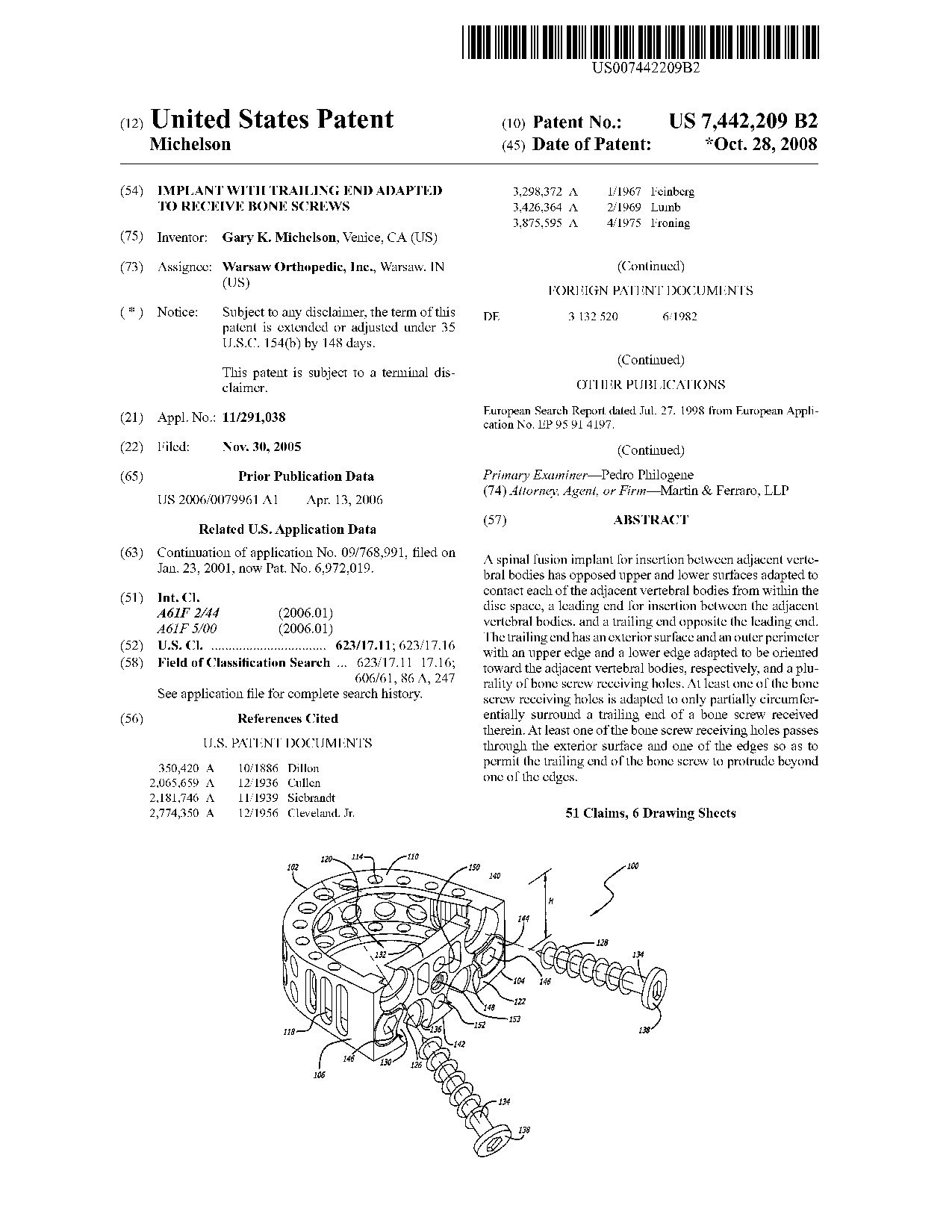 Implant with trailing end adapted to receive bone screws - Patent 7,442,209 Implant with trailing end adapted to receive bone screws - Patent 7,442,209
|
A spinal fusion implant for insertion between adjacent vertebral bodies has opposed upper and lower surfaces adapted to contact each of the adjacent vertebral bodies from within the disc space, a leading end for insertion between the adjacent vertebral bodies, and a trailing end opposite the leading end. The trailing end has an exterior surface and an outer perimeter with an upper edge and a lower edge adapted to be oriented toward the adjacent vertebral bodies, respectively, and a plurality of bone screw receiving holes. At least one of the bone screw receiving holes is adapted to only partially circumferentially surround a trailing end of a bone screw received therein. At least one of the bone screw receiving holes passes through the exterior surface and one of the edges so as to permit the trailing end of the bone screw to protrude beyond one of the edges.
|
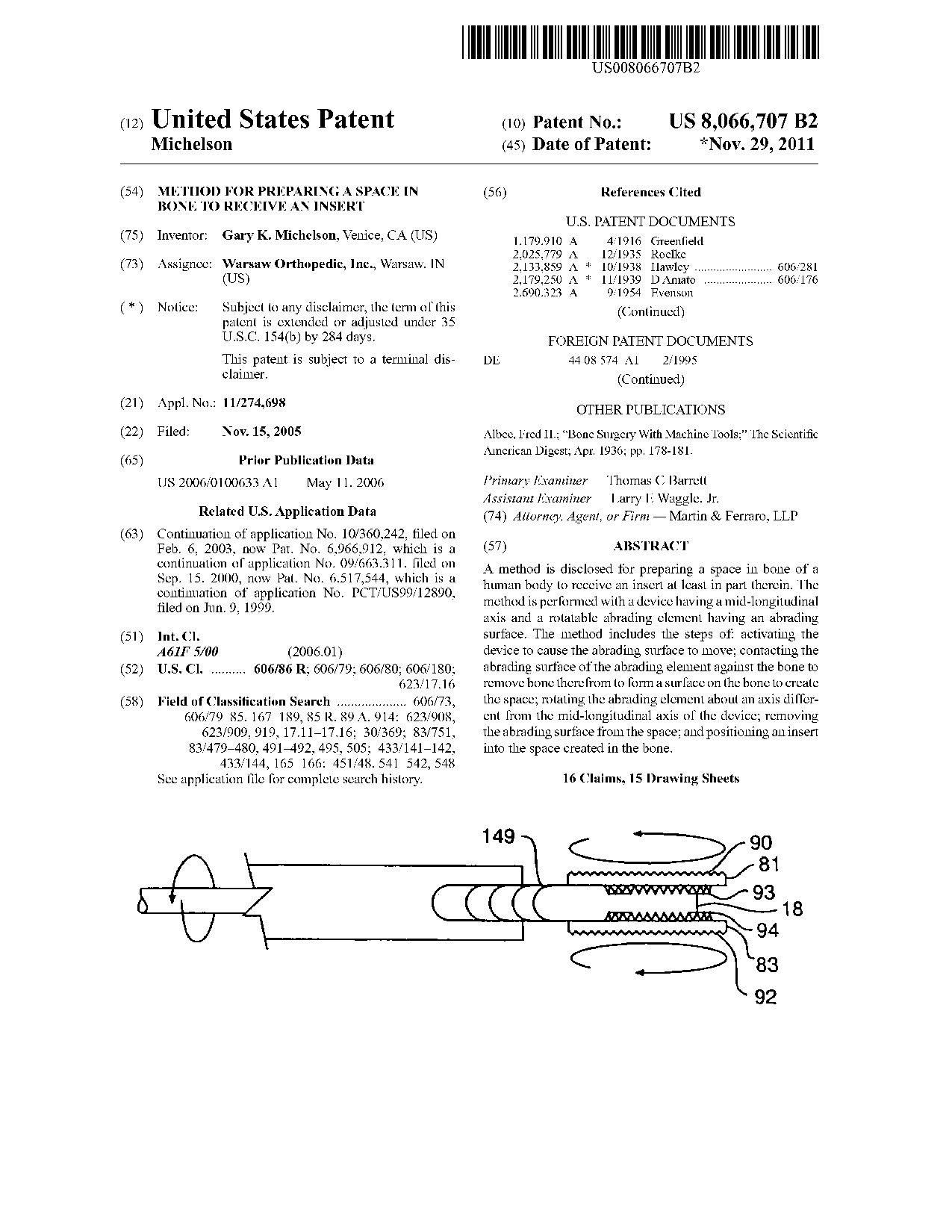 Method for preparing a space in bone to receive an insert - Patent 8,066,707 Method for preparing a space in bone to receive an insert - Patent 8,066,707
|
A method is disclosed for preparing a space in bone of a human body to receive an insert at least in part therein. The method is performed with a device having a mid-longitudinal axis and a rotatable abrading element having an abrading surface. The method includes the steps of: activating the device to cause the abrading surface to move; contacting the abrading surface of the abrading element against the bone to remove bone therefrom to form a surface on the bone to create the space; rotating the abrading element about an axis different from the mid-longitudinal axis of the device; removing the abrading surface from the space; and positioning an insert into the space created in the bone.
|
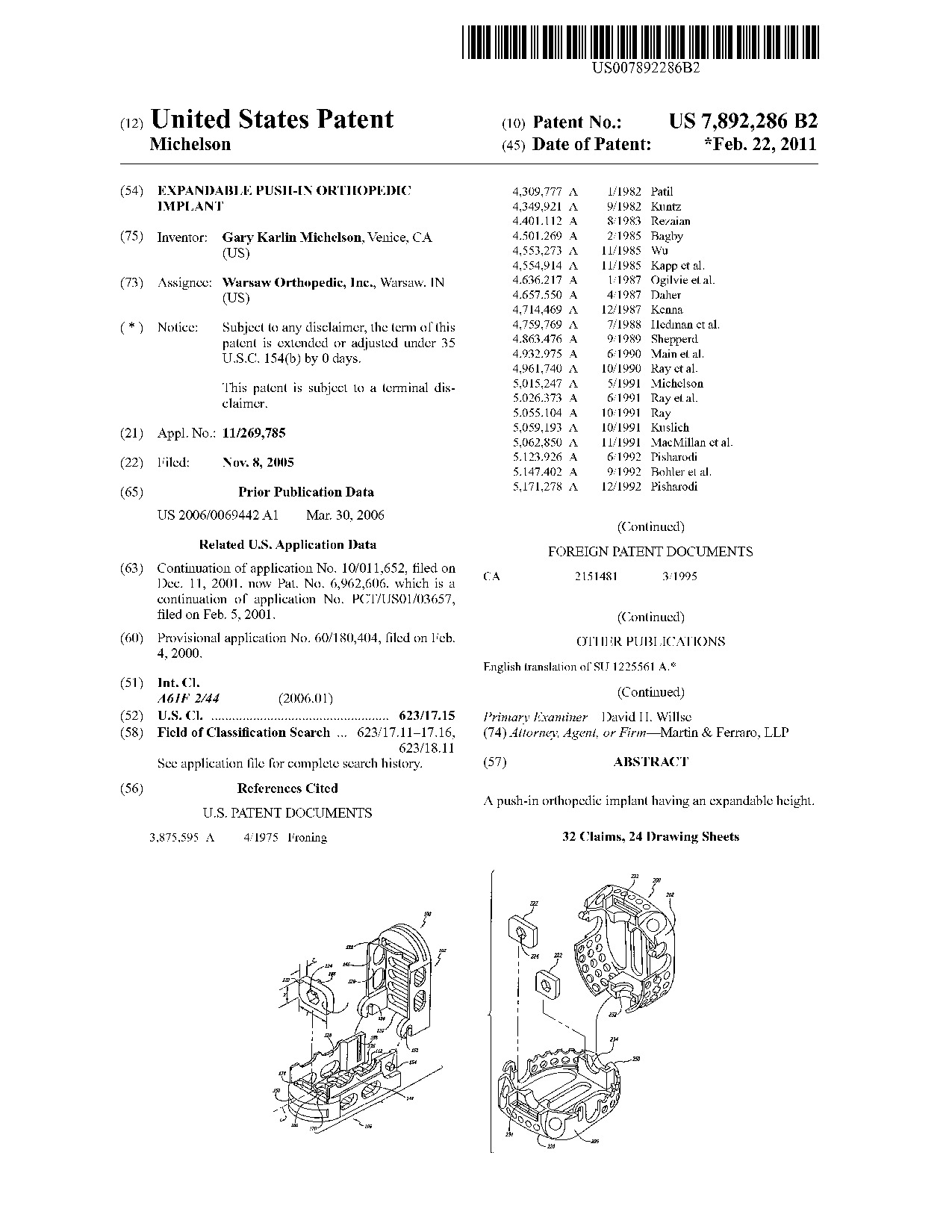 Expandable push-in orthopedic implant - Patent 7,892,286 Expandable push-in orthopedic implant - Patent 7,892,286
|
A push-in orthopedic implant having an expandable height.
|
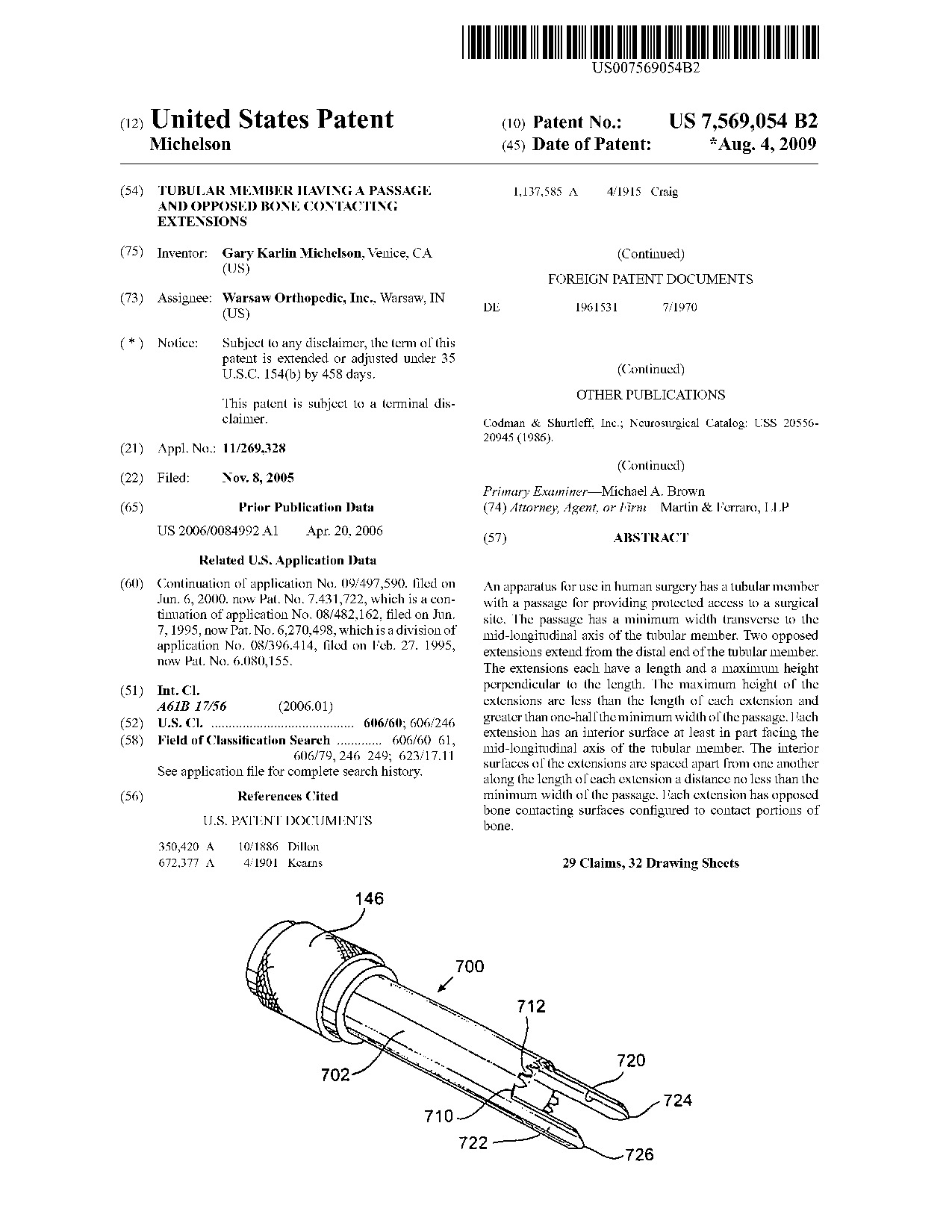 Tubular member having a passage and opposed bone contacting extensions - Patent 7,569,054 Tubular member having a passage and opposed bone contacting extensions - Patent 7,569,054
|
An apparatus for use in human surgery has a tubular member with a passage for providing protected access to a surgical site. The passage has a minimum width transverse to the mid-longitudinal axis of the tubular member. Two opposed extensions extend from the distal end of the tubular member. The extensions each have a length and a maximum height perpendicular to the length. The maximum height of the extensions are less than the length of each extension and greater than one-half the minimum width of the passage. Each extension has an interior surface at least in part facing the mid-longitudinal axis of the tubular member. The interior surfaces of the extensions are spaced apart from one another along the length of each extension a distance no less than the minimum width of the passage. Each extension has opposed bone contacting surfaces configured to contact portions of bone.
|
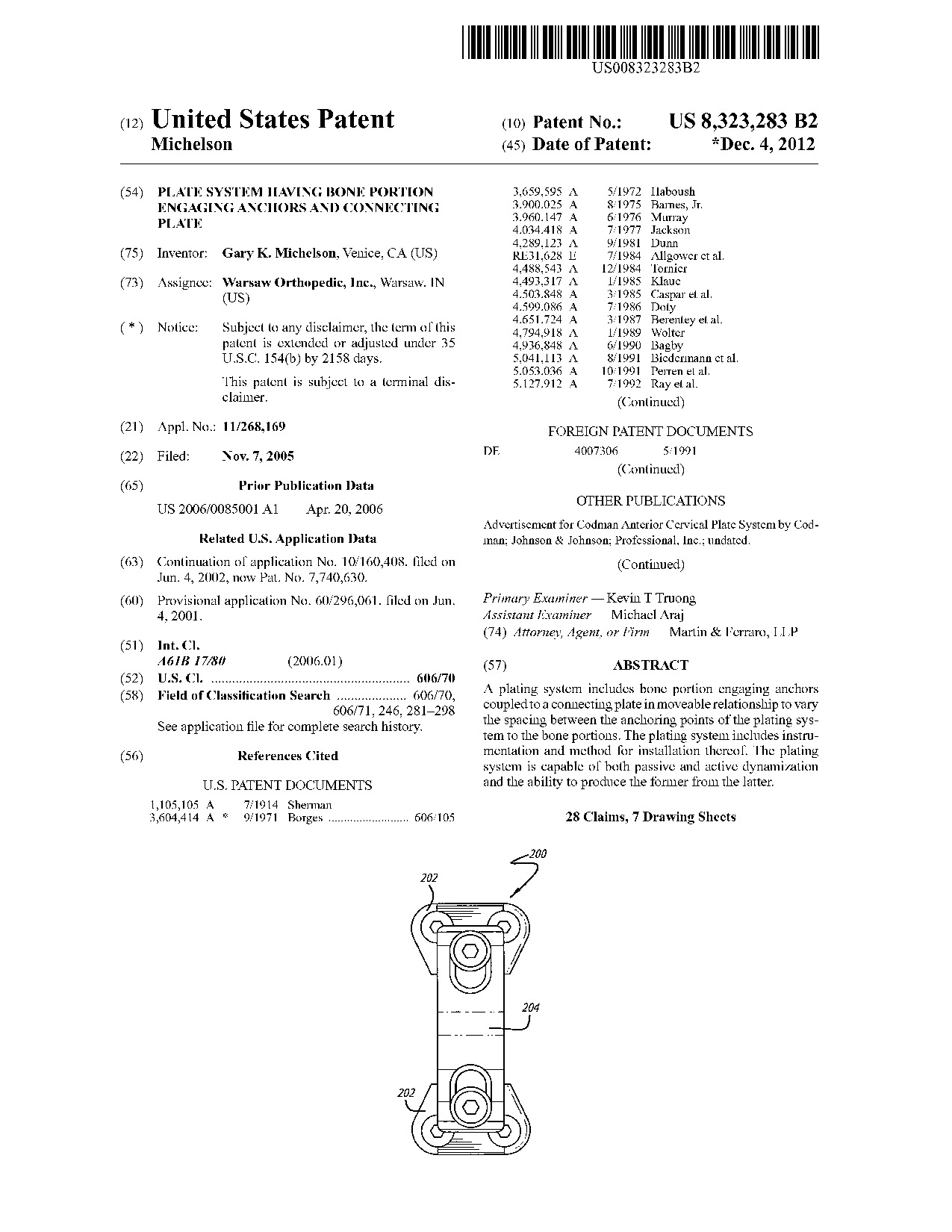 Plate system having bone portion engaging anchors and connecting plate - Patent 8,323,283 Plate system having bone portion engaging anchors and connecting plate - Patent 8,323,283
|
A plating system includes bone portion engaging anchors coupled to a connecting plate in moveable relationship to vary the spacing between the anchoring points of the plating system to the bone portions. The plating system includes instrumentation and method for installation thereof. The plating system is capable of both passive and active dynamization and the ability to produce the former from the latter.
|
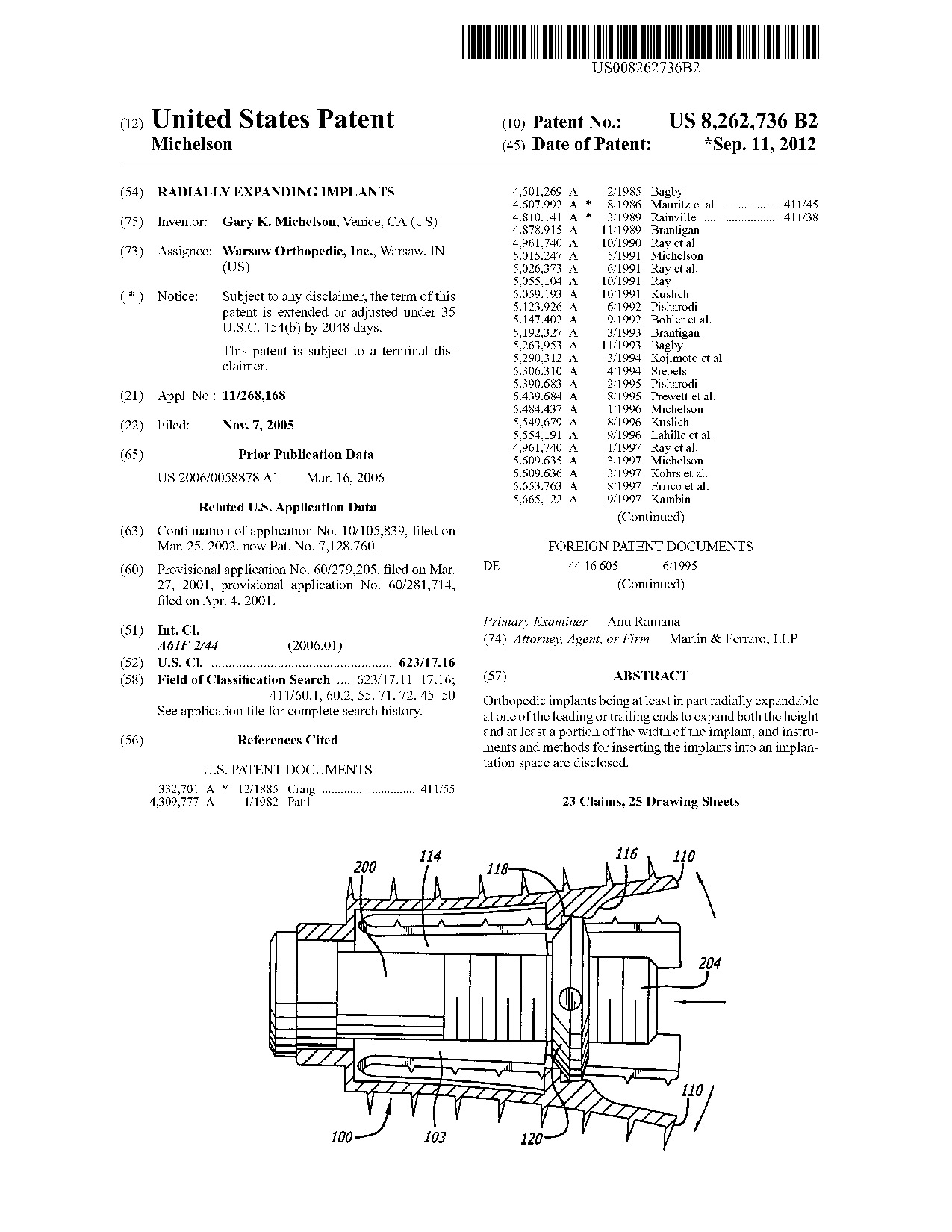 Radially expanding implants - Patent 8,262,736 Radially expanding implants - Patent 8,262,736
|
Orthopedic implants being at least in part radially expandable at one of the leading or trailing ends to expand both the height and at least a portion of the width of the implant, and instruments and methods for inserting the implants into an implantation space are disclosed.
|
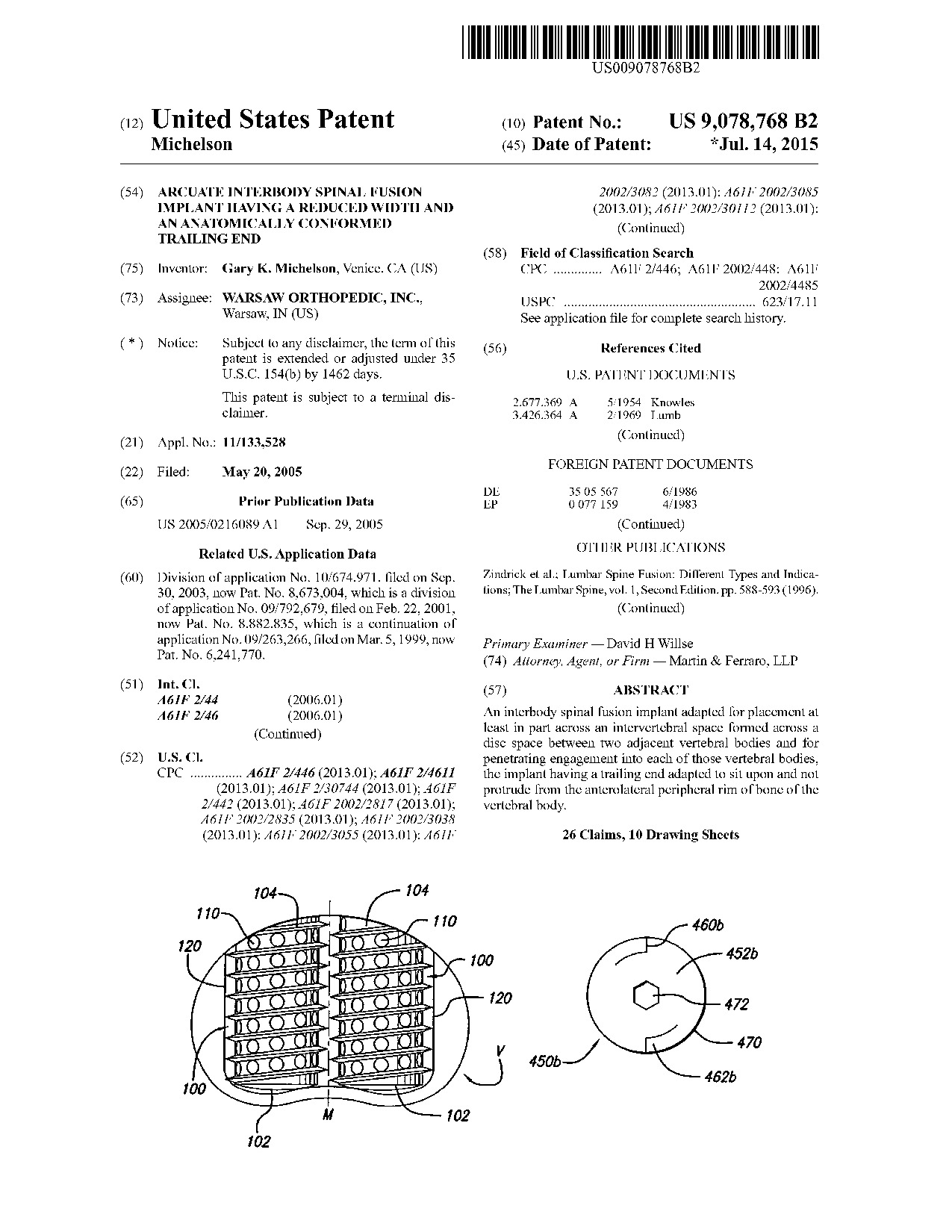 Arcuate interbody spinal fusion implant having a reduced width and an anatomically conformed trailing end - Patent 9,078,768 Arcuate interbody spinal fusion implant having a reduced width and an anatomically conformed trailing end - Patent 9,078,768
|
An interbody spinal fusion implant adapted for placement at least in part across an intervertebral space formed across a disc space between two adjacent vertebral bodies and for penetrating engagement into each of those vertebral bodies, the implant having a trailing end adapted to sit upon and not protrude from the anterolateral peripheral rim of bone of the vertebral body.
|
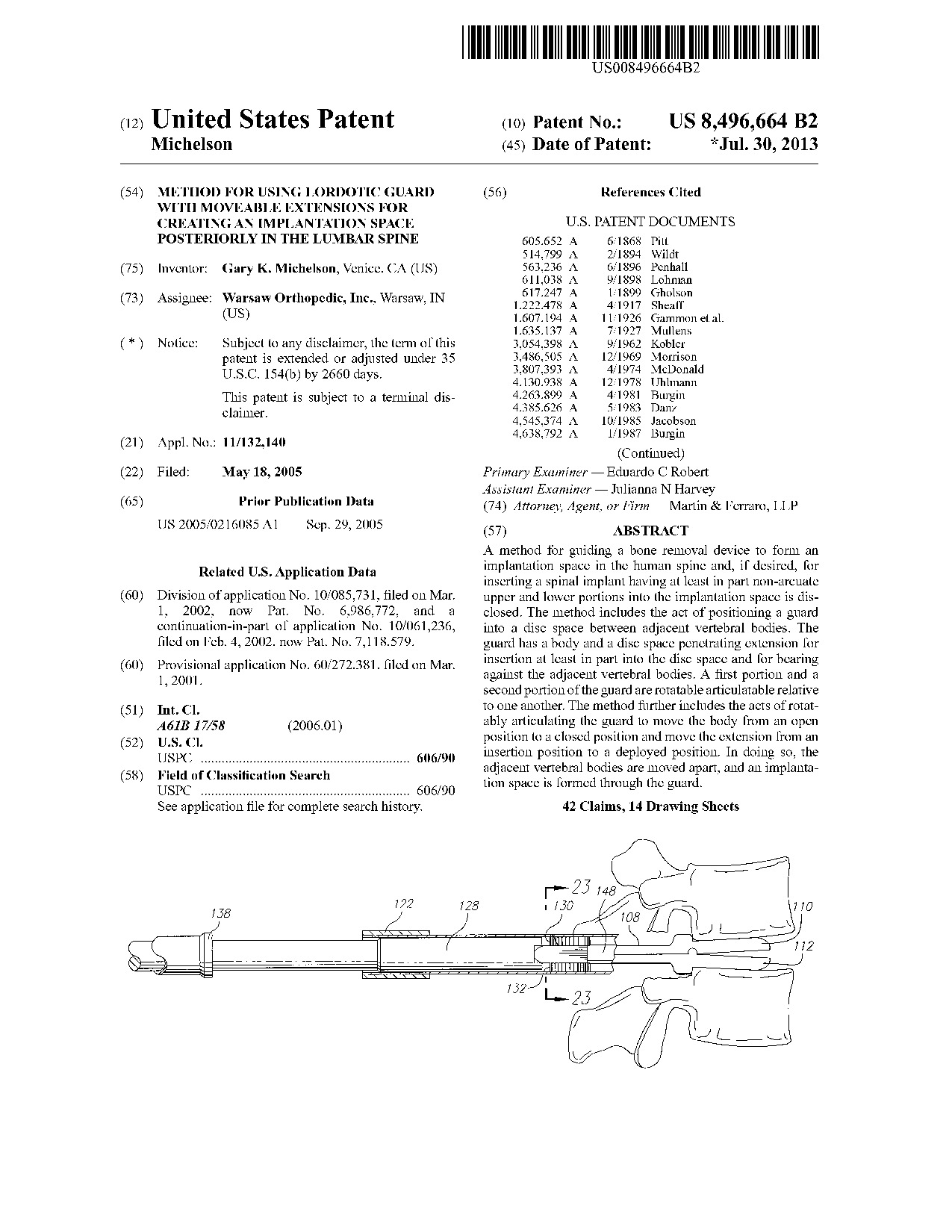 Method for using lordotic guard with moveable extensions for creating an implantation space posteriorly in the lumbar spine - Patent 8,496,664 Method for using lordotic guard with moveable extensions for creating an implantation space posteriorly in the lumbar spine - Patent 8,496,664
|
A method for guiding a bone removal device to form an implantation space in the human spine and, if desired, for inserting a spinal implant having at least in part non-arcuate upper and lower portions into the implantation space is disclosed. The method includes the act of positioning a guard into a disc space between adjacent vertebral bodies. The guard has a body and a disc space penetrating extension for insertion at least in part into the disc space and for bearing against the adjacent vertebral bodies. A first portion and a second portion of the guard are rotatable articulatable relative to one another. The method further includes the acts of rotatably articulating the guard to move the body from an open position to a closed position and move the extension from an insertion position to a deployed position. In doing so, the adjacent vertebral bodies are moved apart, and an implantation space is formed through the guard.
|
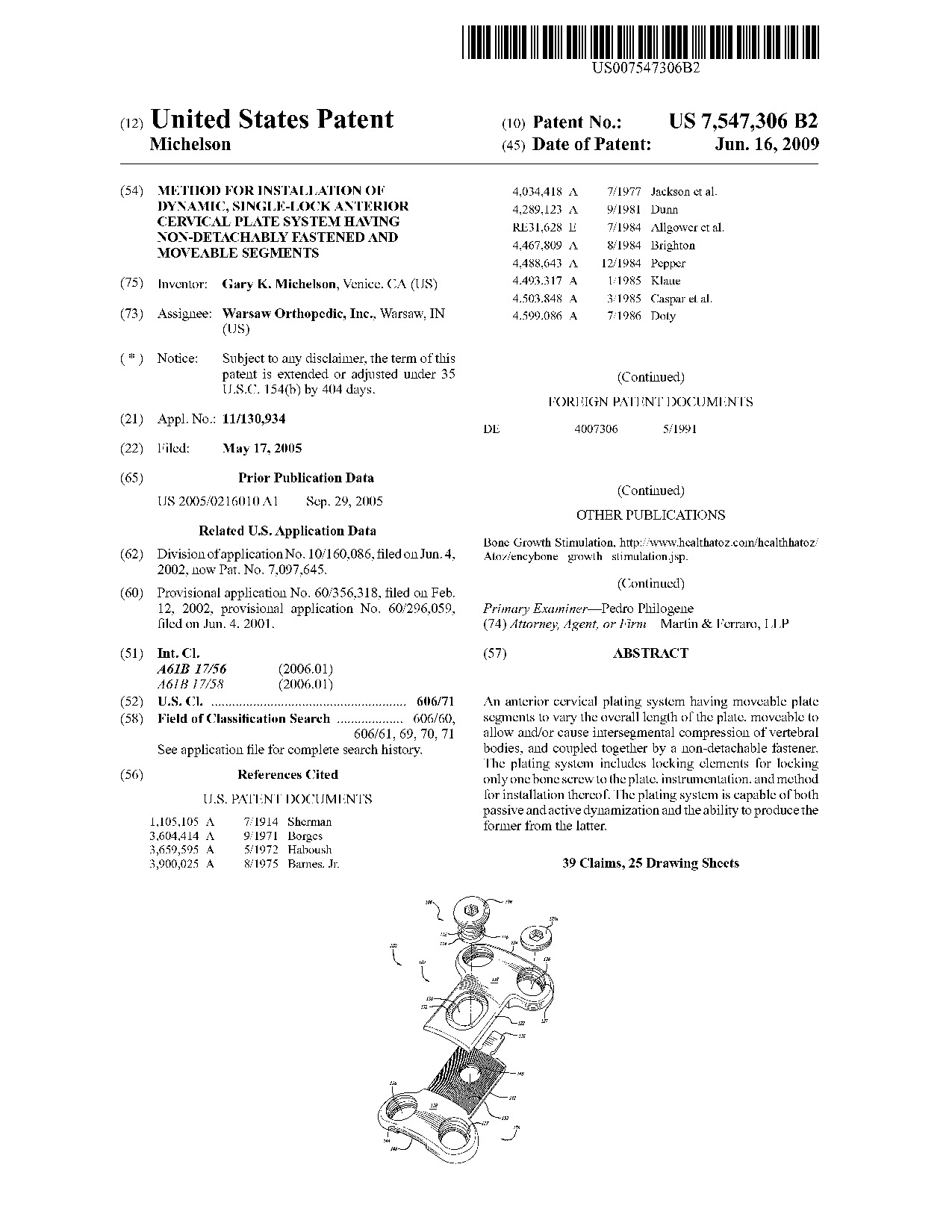 Method for installation of dynamic, single-lock anterior cervical plate system having non-detachably fastened and moveable segments - Patent 7,547,306 Method for installation of dynamic, single-lock anterior cervical plate system having non-detachably fastened and moveable segments - Patent 7,547,306
|
An anterior cervical plating system having moveable plate segments to vary the overall length of the plate, moveable to allow and/or cause intersegmental compression of vertebral bodies, and coupled together by a non-detachable fastener. The plating system includes locking elements for locking only one bone screw to the plate, instrumentation, and method for installation thereof. The plating system is capable of both passive and active dynamization and the ability to produce the former from the latter.
|
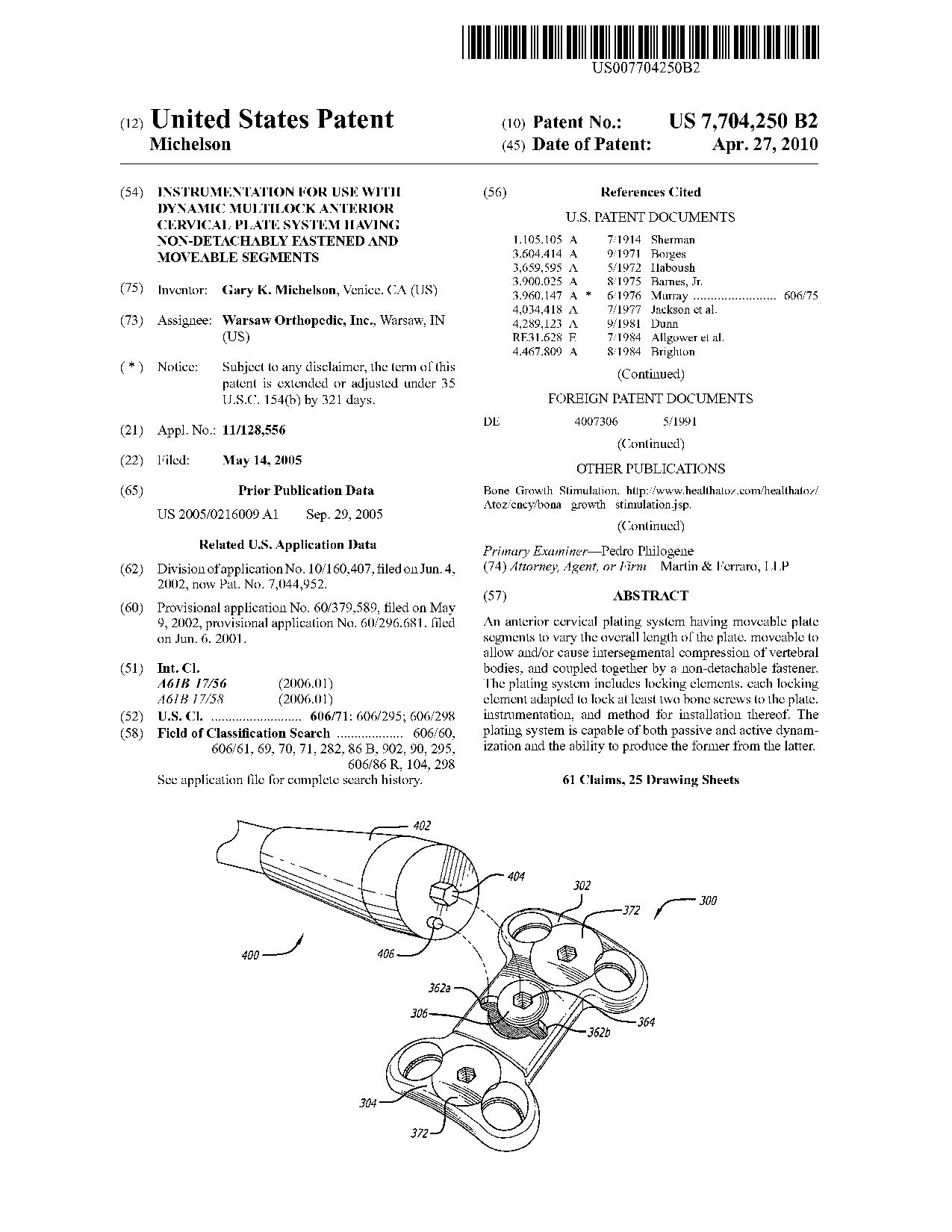 Instrumentation for use with dynamic multilock anterior cervical plate system having non-detachably fastened and moveable segments - Patent 7,704,250 Instrumentation for use with dynamic multilock anterior cervical plate system having non-detachably fastened and moveable segments - Patent 7,704,250
|
An anterior cervical plating system having moveable plate segments to vary the overall length of the plate, moveable to allow and/or cause intersegmental compression of vertebral bodies, and coupled together by a non-detachable fastener. The plating system includes locking elements, each locking element adapted to lock at least two bone screws to the plate, instrumentation, and method for installation thereof. The plating system is capable of both passive and active dynamization and the ability to produce the former from the latter.
|
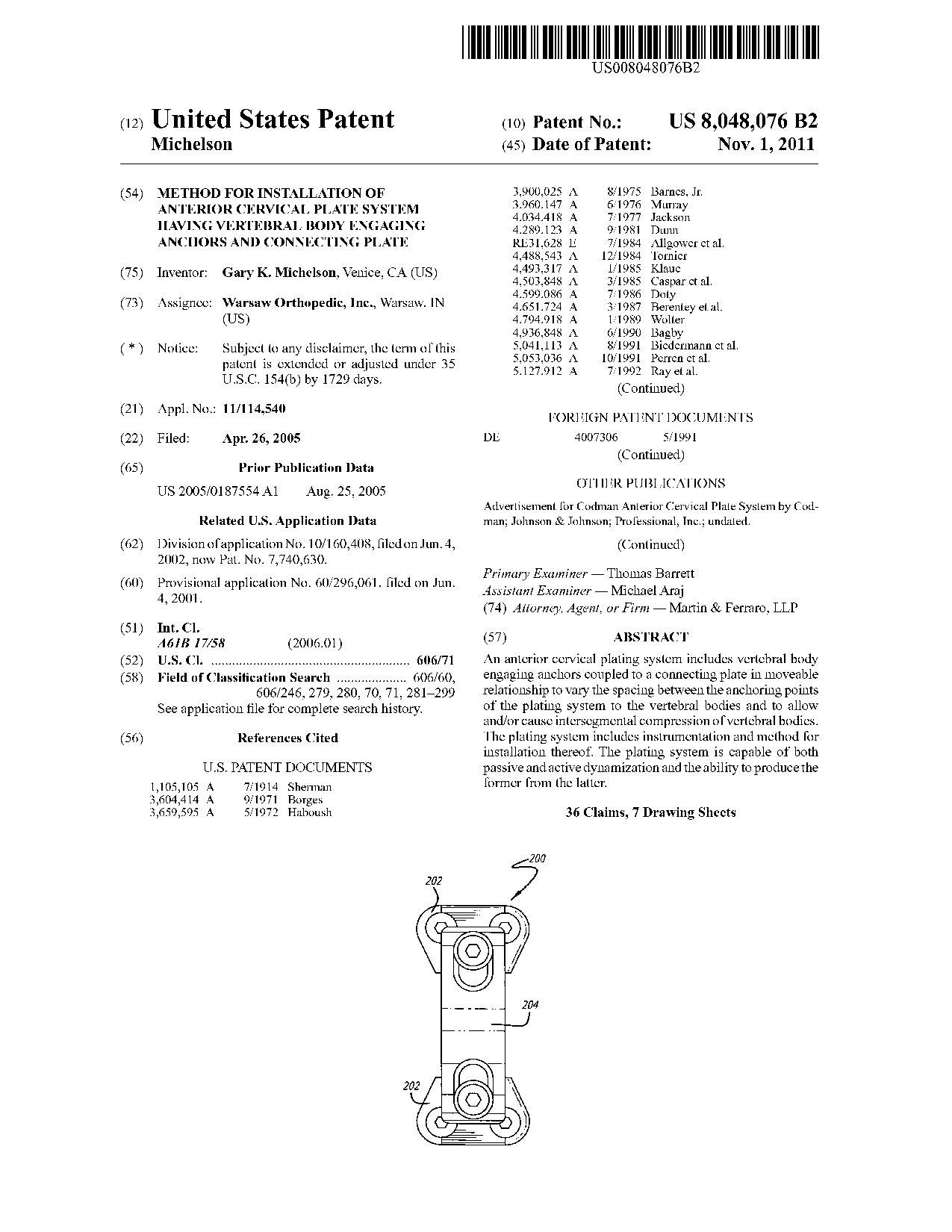 Method for installation of anterior cervical plate system having vertebral body engaging anchors and connecting plate - Patent 8,048,076 Method for installation of anterior cervical plate system having vertebral body engaging anchors and connecting plate - Patent 8,048,076
|
An anterior cervical plating system includes vertebral body engaging anchors coupled to a connecting plate in moveable relationship to vary the spacing between the anchoring points of the plating system to the vertebral bodies and to allow and/or cause intersegmental compression of vertebral bodies. The plating system includes instrumentation and method for installation thereof. The plating system is capable of both passive and active dynamization and the ability to produce the former from the latter.
|
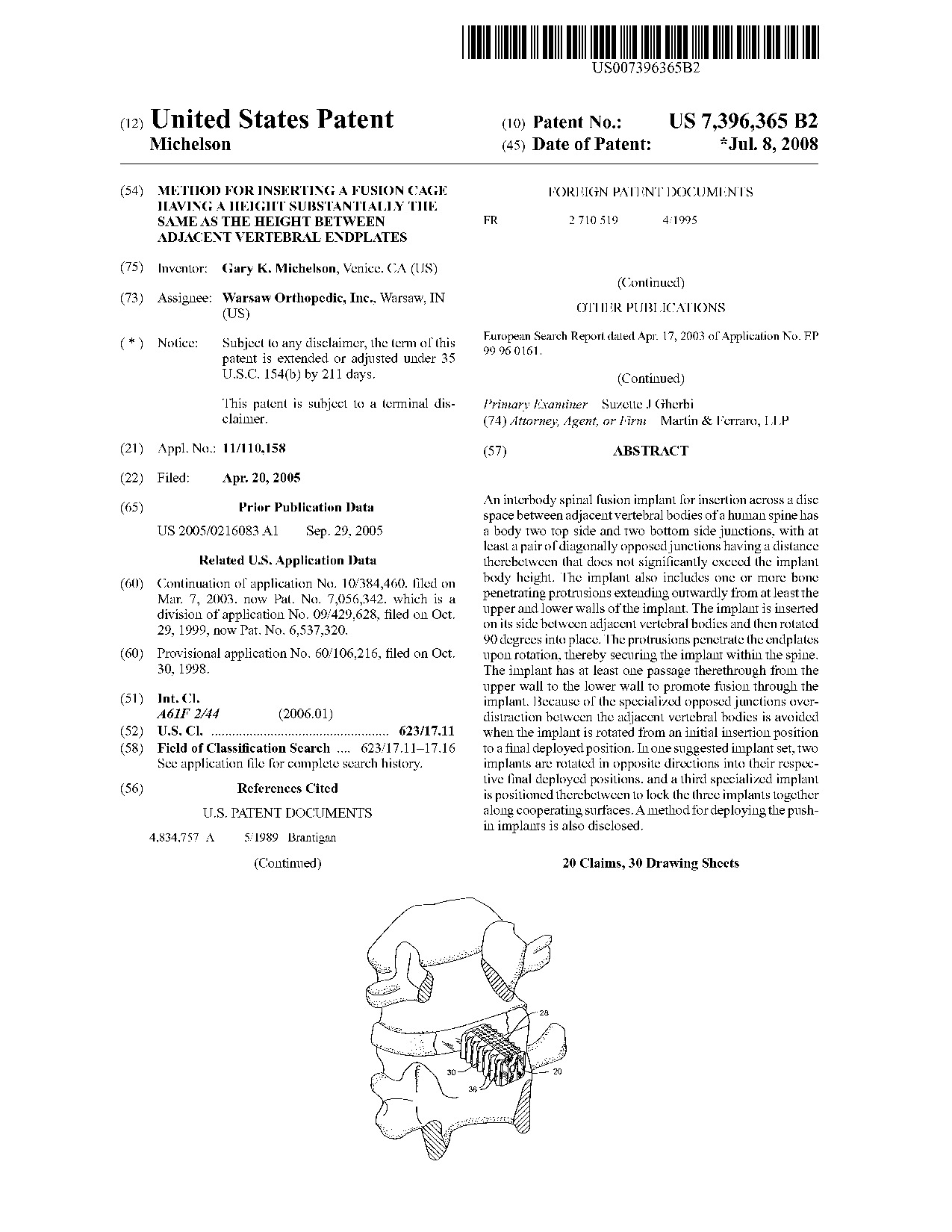 Method for inserting a fusion cage having a height substantially the same as the height between adjacent vertebral endplates - Patent 7,396,365 Method for inserting a fusion cage having a height substantially the same as the height between adjacent vertebral endplates - Patent 7,396,365
|
An interbody spinal fusion implant for insertion across a disc space between adjacent vertebral bodies of a human spine has a body two top side and two bottom side junctions, with at least a pair of diagonally opposed junctions having a distance therebetween that does not significantly exceed the implant body height. The implant also includes one or more bone penetrating protrusions extending outwardly from at least the upper and lower walls of the implant. The implant is inserted on its side between adjacent vertebral bodies and then rotated 90 degrees into place. The protrusions penetrate the endplates upon rotation, thereby securing the implant within the spine. The implant has at least one passage therethrough from the upper wall to the lower wall to promote fusion through the implant. Because of the specialized opposed junctions overdistraction between the adjacent vertebral bodies is avoided when the implant is rotated from an initial insertion position to a final deployed position. In one suggested implant set, two implants are rotated in opposite directions into their respective final deployed positions, and a third specialized implant is positioned therebetween to lock the three implants together along cooperating surfaces. A method for deploying the push-in implants is also disclosed.
|
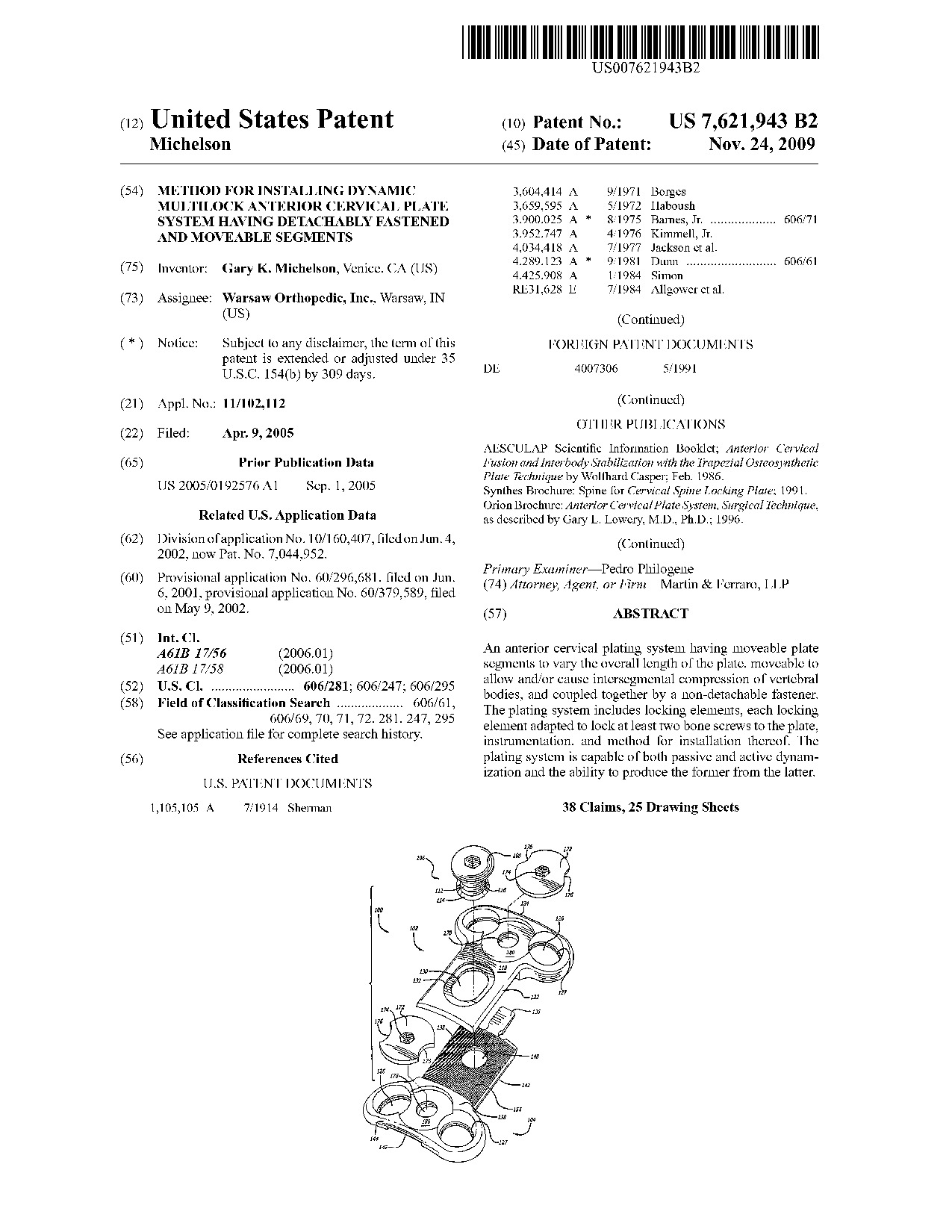 Method for installing dynamic multilock anterior cervical plate system having detachably fastened and moveable segments - Patent 7,621,943 Method for installing dynamic multilock anterior cervical plate system having detachably fastened and moveable segments - Patent 7,621,943
|
An anterior cervical plating system having moveable plate segments to vary the overall length of the plate, moveable to allow and/or cause intersegmental compression of vertebral bodies, and coupled together by a non-detachable fastener. The plating system includes locking elements, each locking element adapted to lock at least two bone screws to the plate, instrumentation, and method for installation thereof. The plating system is capable of both passive and active dynamization and the ability to produce the former from the latter.
|
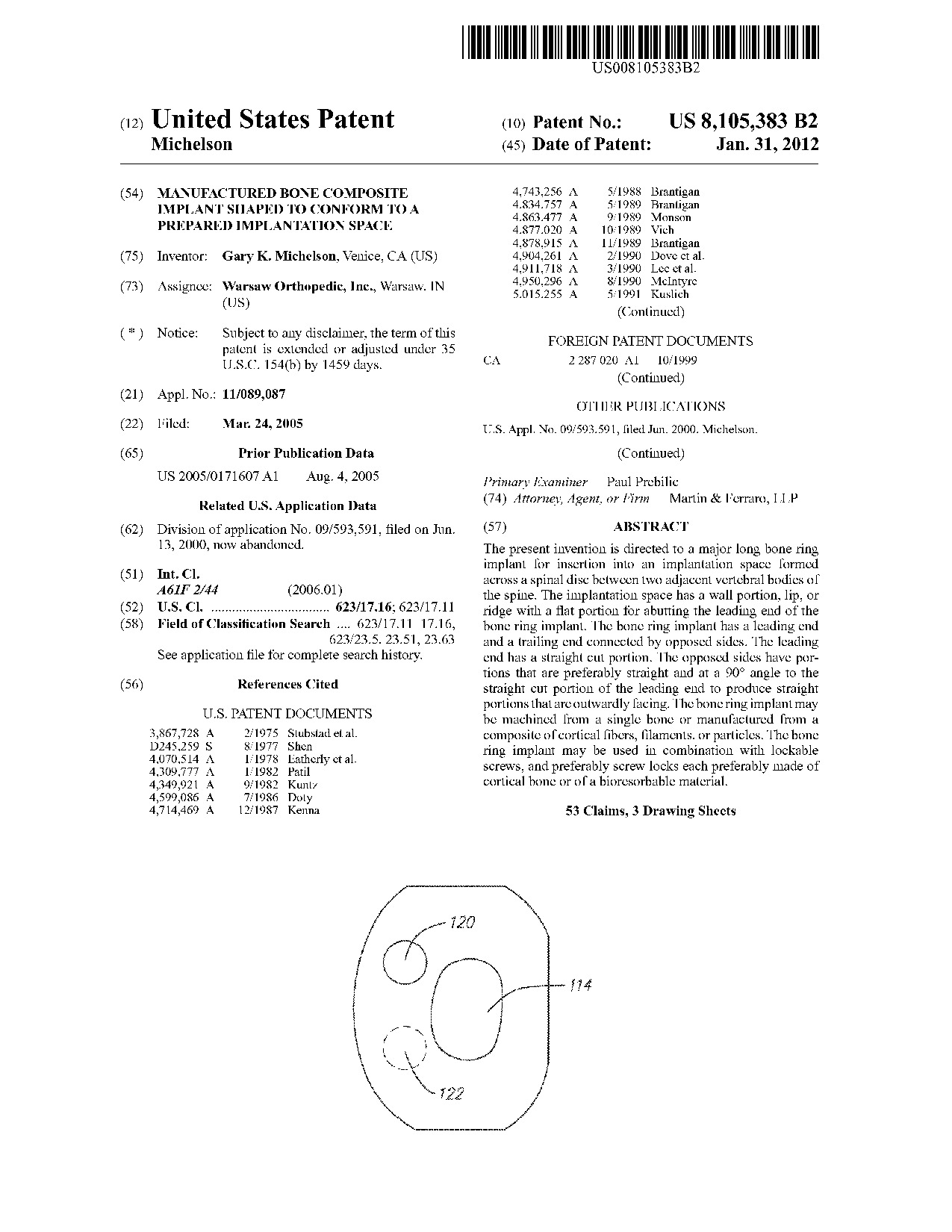 Manufactured bone composite implant shaped to conform to a prepared implantation space - Patent 8,105,383 Manufactured bone composite implant shaped to conform to a prepared implantation space - Patent 8,105,383
|
The present invention is directed to a major long bone ring implant for insertion into an implantation space formed across a spinal disc between two adjacent vertebral bodies of the spine. The implantation space has a wall portion, lip, or ridge with a flat portion for abutting the leading end of the bone ring implant. The bone ring implant has a leading end and a trailing end connected by opposed sides. The leading end has a straight cut portion. The opposed sides have portions that are preferably straight and at a 90.degree. angle to the straight cut portion of the leading end to produce straight portions that are outwardly facing. The bone ring implant may be machined from a single bone or manufactured from a composite of cortical fibers, filaments, or particles. The bone ring implant may be used in combination with lockable screws, and preferably screw locks each preferably made of cortical bone or of a bioresorbable material.
|
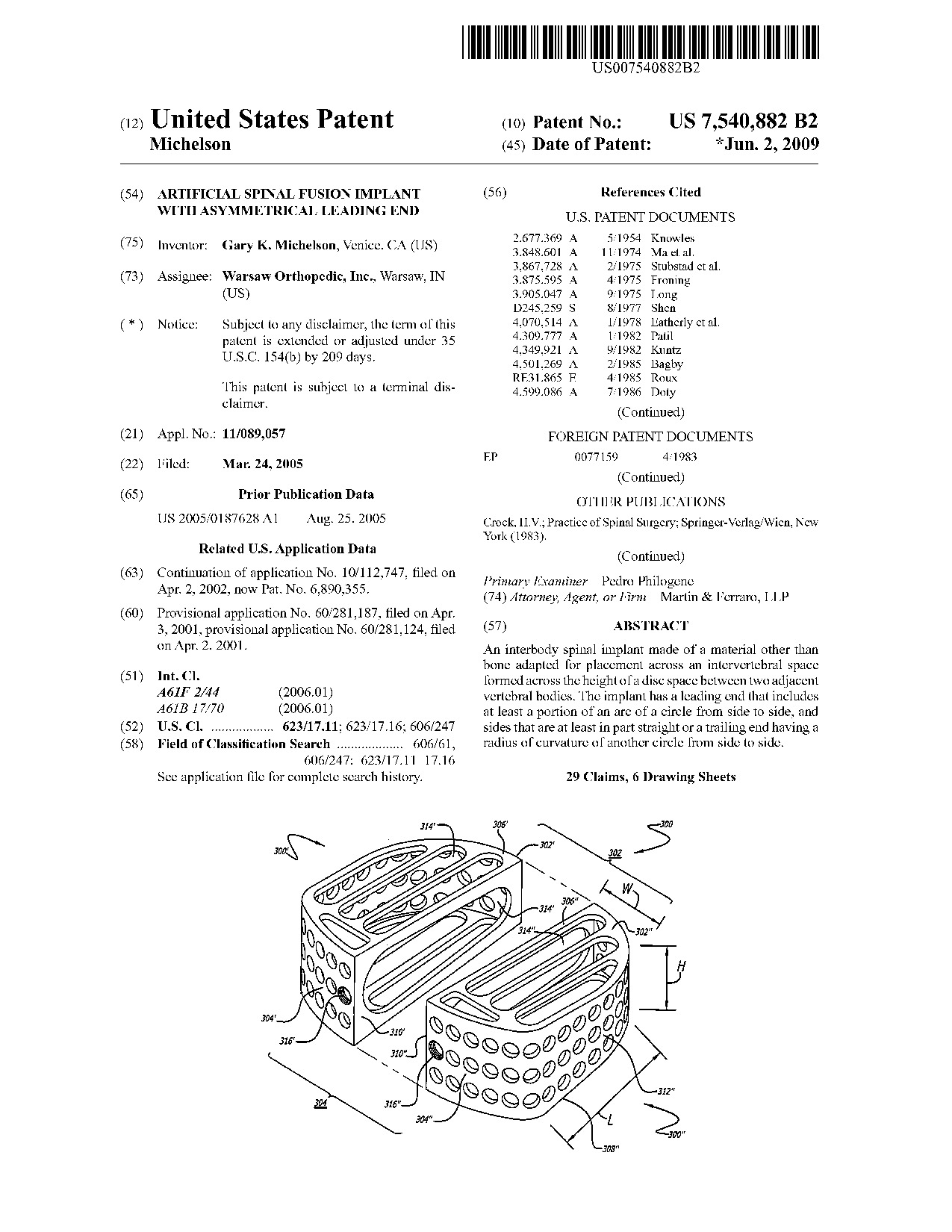 Artificial spinal fusion implant with asymmetrical leading end - Patent 7,540,882 Artificial spinal fusion implant with asymmetrical leading end - Patent 7,540,882
|
An interbody spinal implant made of a material other than bone adapted for placement across an intervertebral space formed across the height of a disc space between two adjacent vertebral bodies. The implant has a leading end that includes at least a portion of an arc of a circle from side to side, and sides that are at least in part straight or a trailing end having a radius of curvature of another circle from side to side.
|
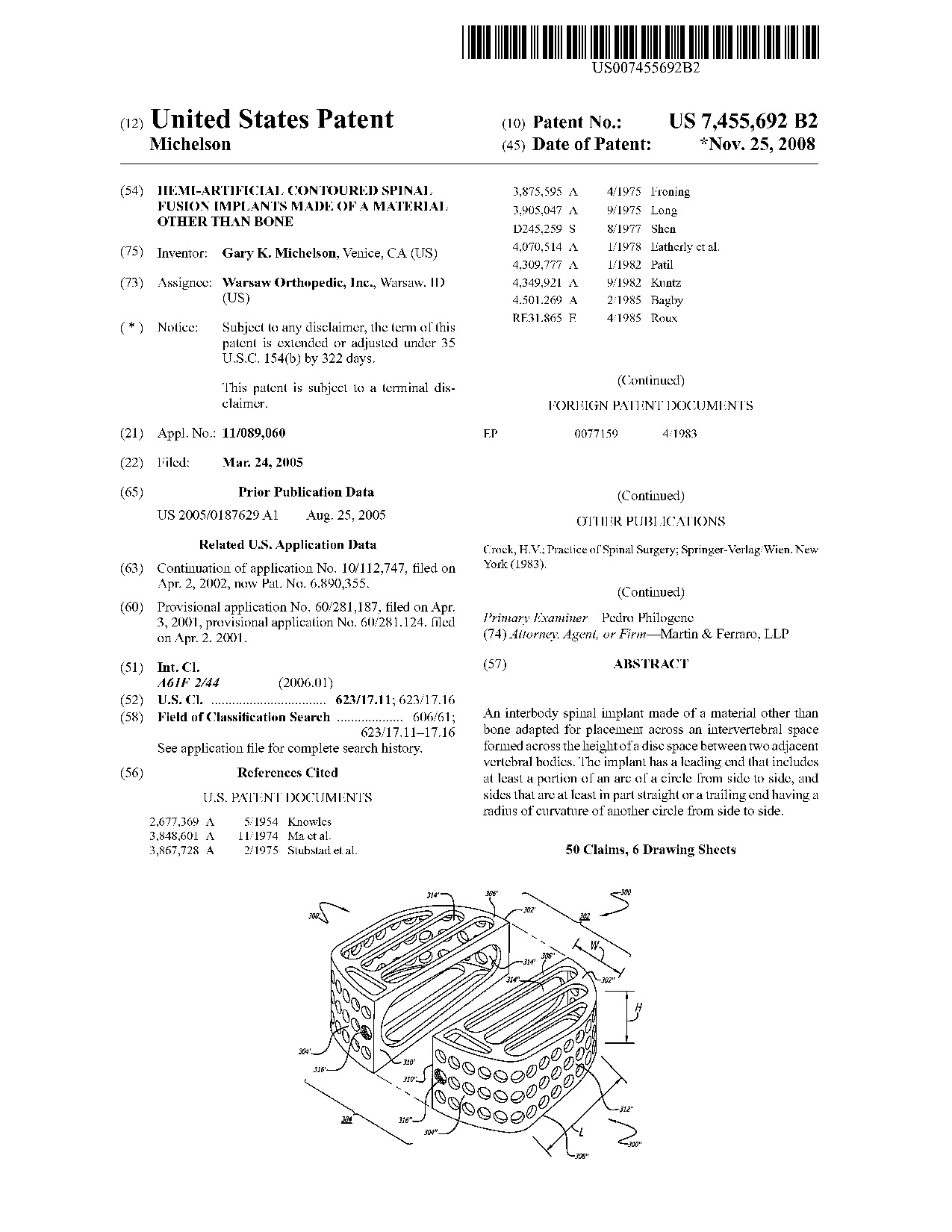 Hemi-artificial contoured spinal fusion implants made of a material other than bone - Patent 7,455,692 Hemi-artificial contoured spinal fusion implants made of a material other than bone - Patent 7,455,692
|
An interbody spinal implant made of a material other than bone adapted for placement across an intervertebral space formed across the height of a disc space between two adjacent vertebral bodies. The implant has a leading end that includes at least a portion of an arc of a circle from side to side, and sides that are at least in part straight or a trailing end having a radius of curvature of another circle from side to side.
|
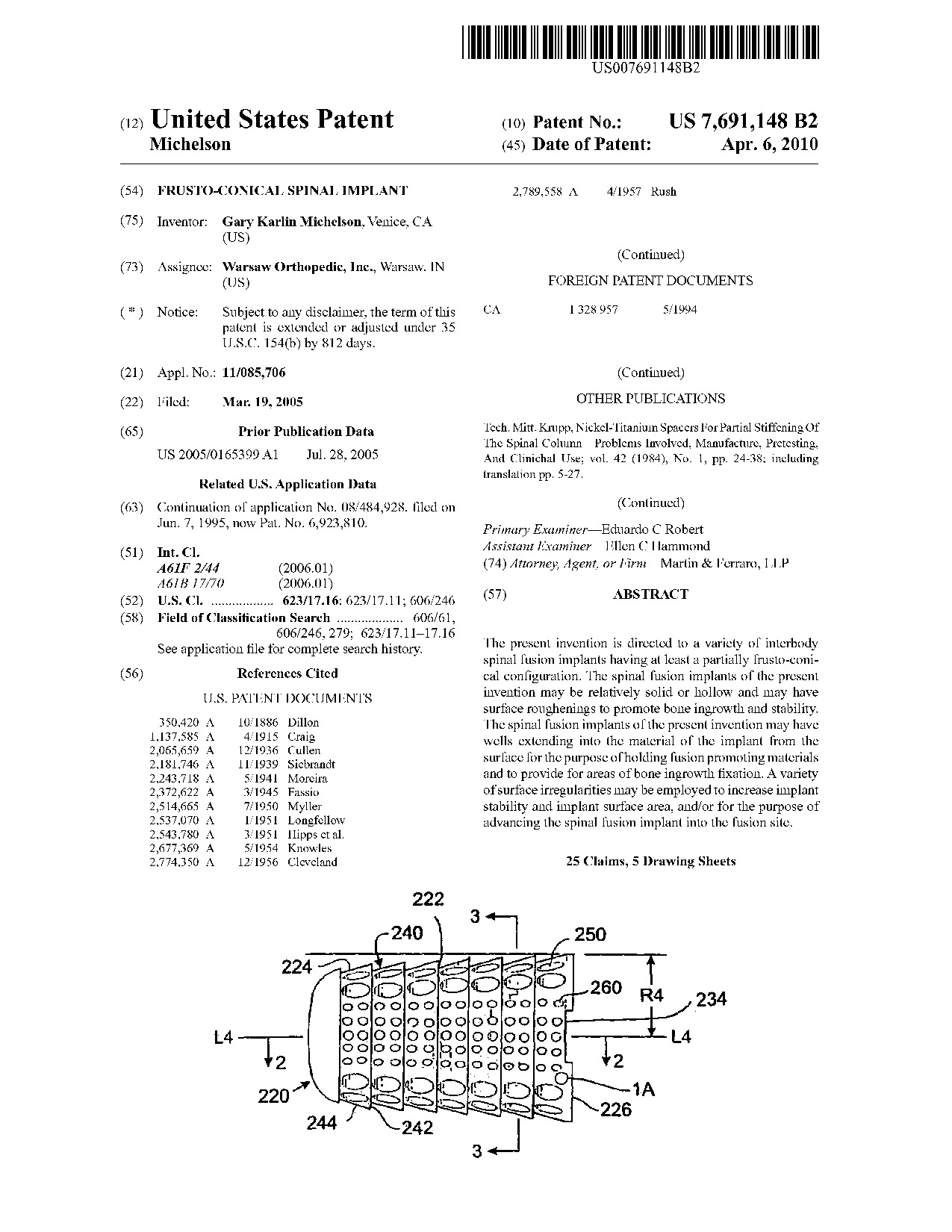 Frusto-conical spinal implant - Patent 7,691,148 Frusto-conical spinal implant - Patent 7,691,148
|
The present invention is directed to a variety of interbody spinal fusion implants having at least a partially frusto-conical configuration. The spinal fusion implants of the present invention may be relatively solid or hollow and may have surface roughenings to promote bone ingrowth and stability. The spinal fusion implants of the present invention may have wells extending into the material of the implant from the surface for the purpose of holding fusion promoting materials and to provide for areas of bone ingrowth fixation. A variety of surface irregularities may be employed to increase implant stability and implant surface area, and/or for the purpose of advancing the spinal fusion implant into the fusion site.
|
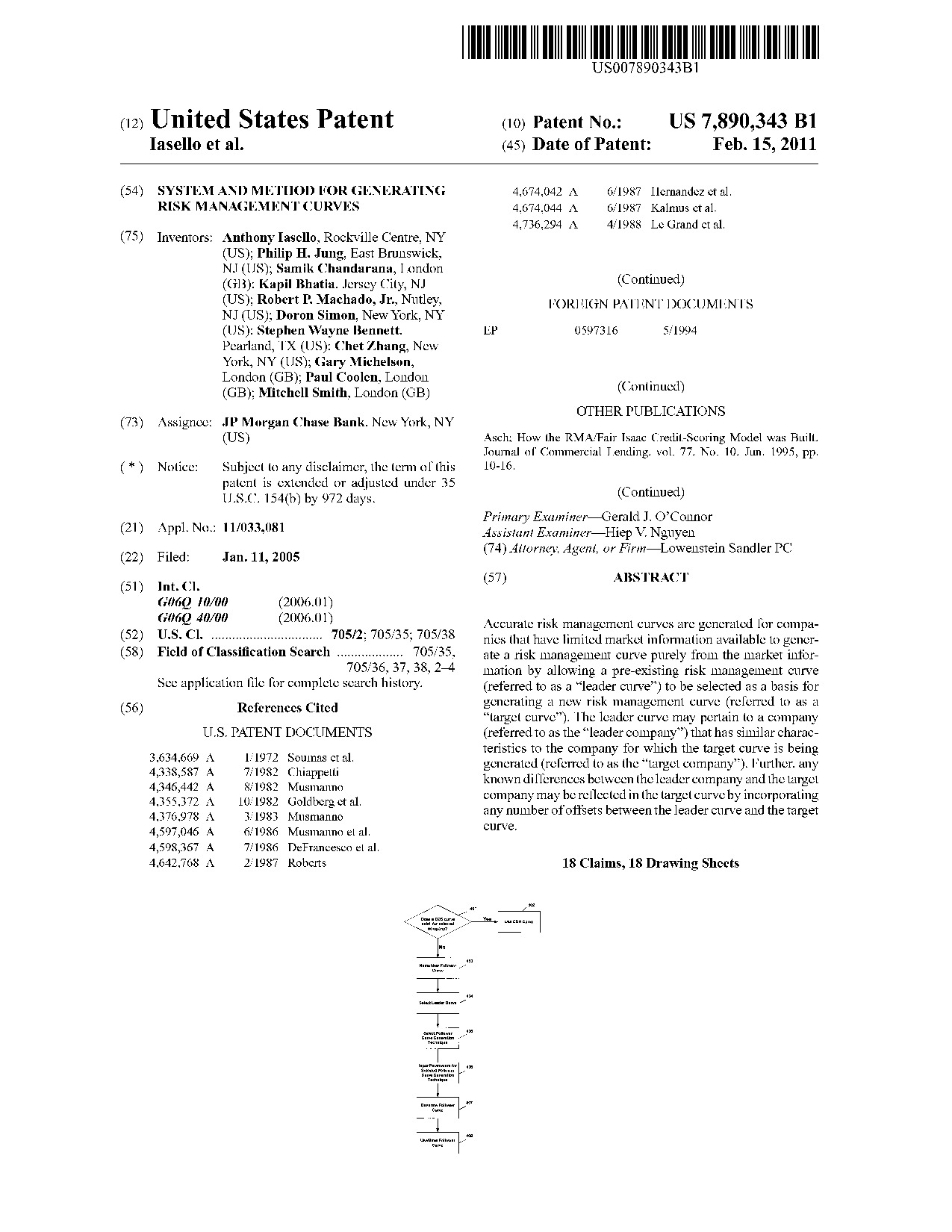 System and method for generating risk management curves - Patent 7,890,343 System and method for generating risk management curves - Patent 7,890,343
|
Accurate risk management curves are generated for companies that have limited market information available to generate a risk management curve purely from the market information by allowing a pre-existing risk management curve (referred to as a "leader curve") to be selected as a basis for generating a new risk management curve (referred to as a "target curve"). The leader curve may pertain to a company (referred to as the "leader company") that has similar characteristics to the company for which the target curve is being generated (referred to as the "target company"). Further, any known differences between the leader company and the target company may be reflected in the target curve by incorporating any number of offsets between the leader curve and the target curve.
|
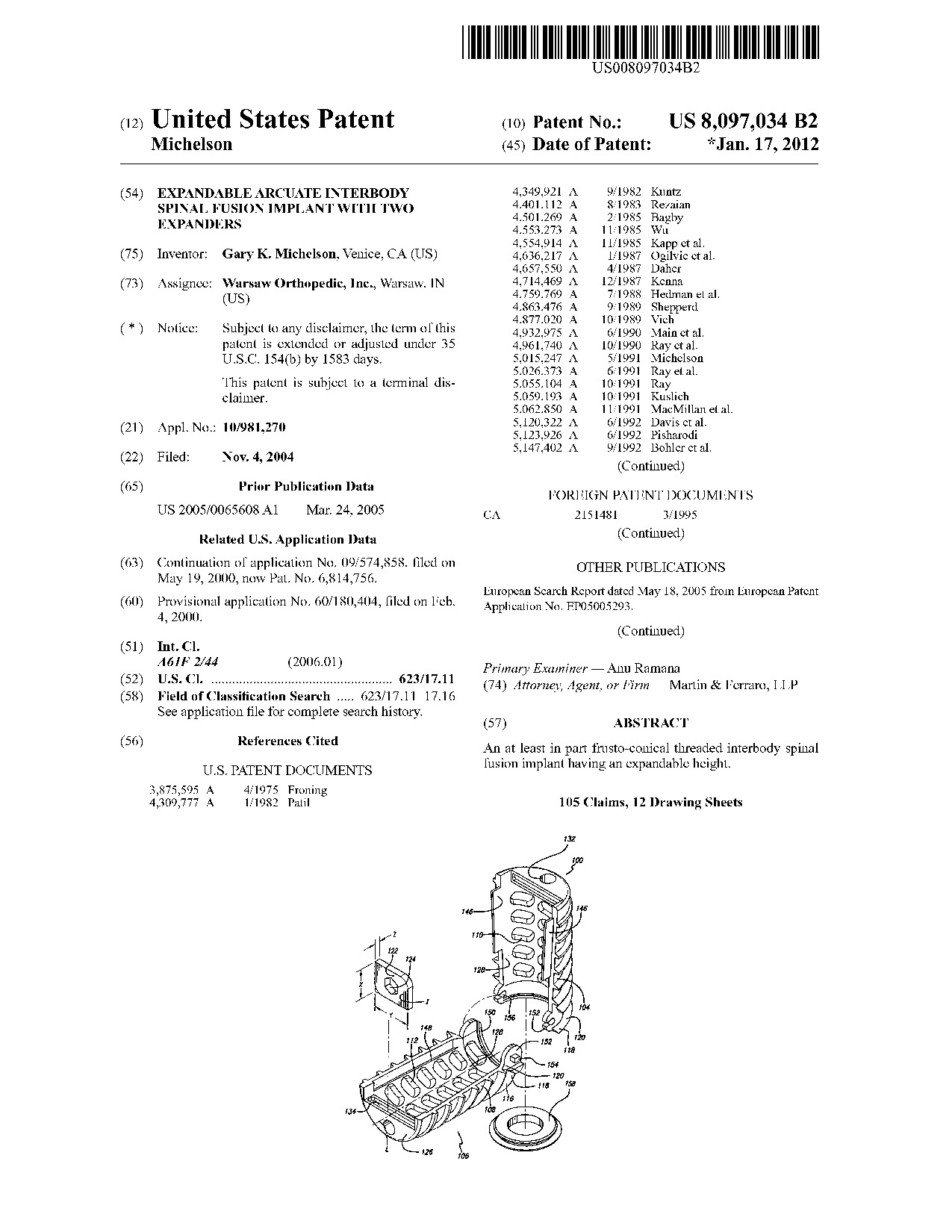 Expandable arcuate interbody spinal fusion implant with two expanders - Patent 8,097,034 Expandable arcuate interbody spinal fusion implant with two expanders - Patent 8,097,034
|
An at least in part frusto-conical threaded interbody spinal fusion implant having an expandable height.
|
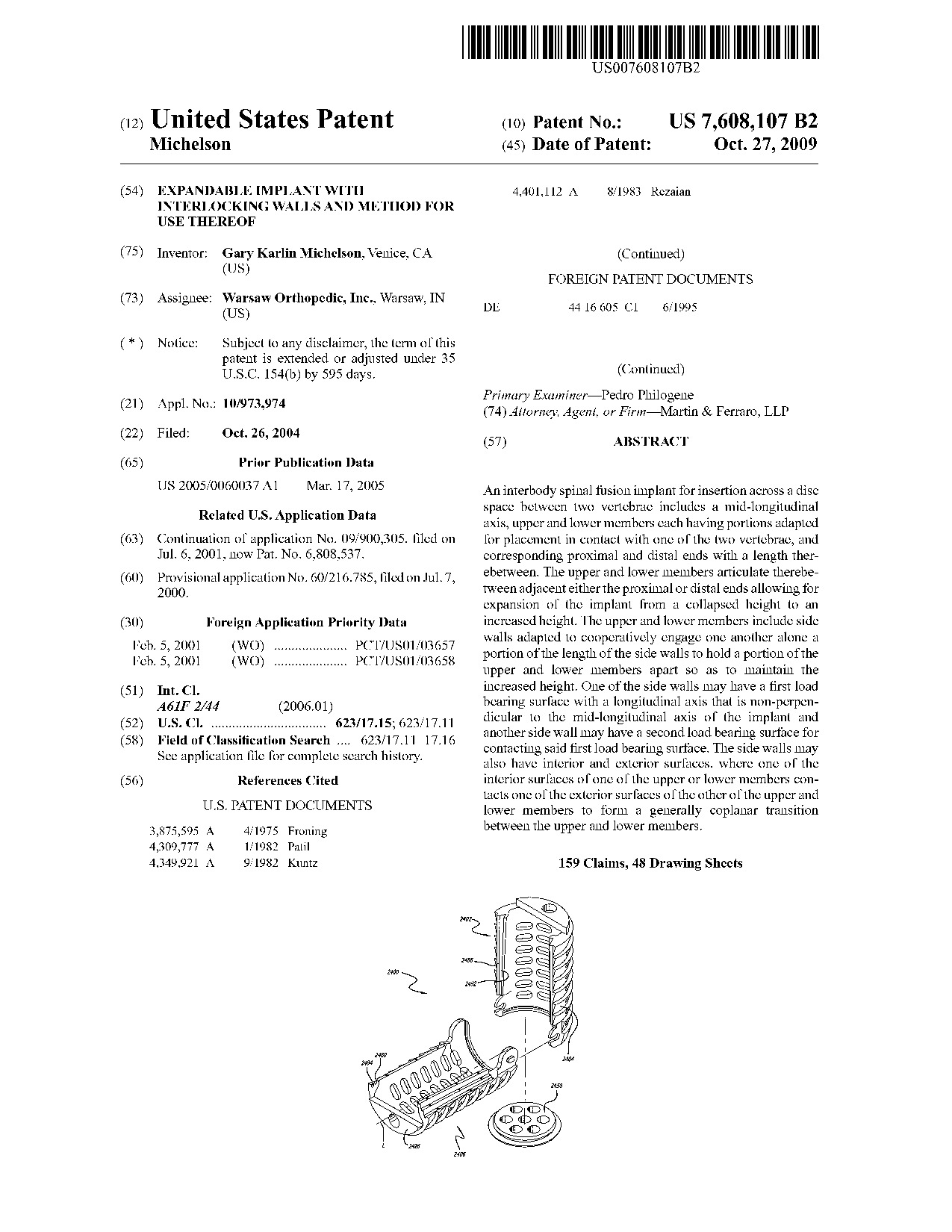 Expandable implant with interlocking walls and method for use thereof - Patent 7,608,107 Expandable implant with interlocking walls and method for use thereof - Patent 7,608,107
|
An interbody spinal fusion implant for insertion across a disc space between two vertebrae includes a mid-longitudinal axis, upper and lower members each having portions adapted for placement in contact with one of the two vertebrae, and corresponding proximal and distal ends with a length therebetween. The upper and lower members articulate therebetween adjacent either the proximal or distal ends allowing for expansion of the implant from a collapsed height to an increased height. The upper and lower members include side walls adapted to cooperatively engage one another alone a portion of the length of the side walls to hold a portion of the upper and lower members apart so as to maintain the increased height. One of the side walls may have a first load bearing surface with a longitudinal axis that is non-perpendicular to the mid-longitudinal axis of the implant and another side wall may have a second load bearing surface for contacting said first load bearing surface. The side walls may also have interior and exterior surfaces, where one of the interior surfaces of one of the upper or lower members contacts one of the exterior surfaces of the other of the upper and lower members to form a generally coplanar transition between the upper and lower members.
|
